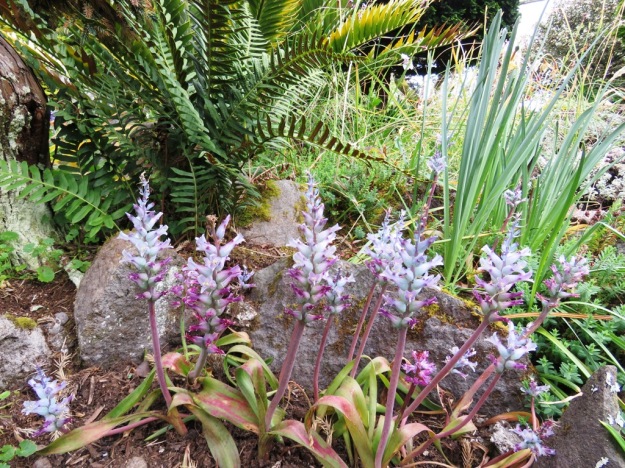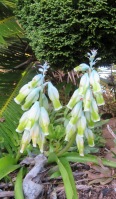
Left to right, probably arbuthnotiae, aloides tricolor, aloides vanzyliae, glaucina x 2, mutabilis, what came to us as carnosa but probably a hybrid, don’t know (or can’t remember) and contaminata – a round up of some currently in flower this morning
Back in August 2015, I wrote what I called part one about lachenalias, covering the early bloomers. It has taken me three years but I return with part two on the late bloomers. Back in our days of putting out a mail order catalogue, we used to offer a range of over a dozen different lachenalias, all but one or two being species, and we gathered up every different one we could find for the garden. By the way, our last mail order catalogue went out in 2003 (yes! 2003!) so we have long since stopped supplying plants. If you are in New Zealand, try Trade Me which is one of the last places you can source some of these less common bulbs.
In the years since, some have proven themselves in the garden and others have faded away. The early season varieties in that first post are all easy and reliable as garden plants (L. bulbifera, L. aloides quadricolor, L. aloides var. aloides and Mark’s L. reflexa hybrid). Others are best kept in pots if you want to ensure their continued survival.

Lachenalia glaucina flowers, nestled in amongst the foliage of narcissi which have already finished blooming. The lachenalia’s foliage is much sparser and close to the ground
In the blues the absolute stand-out is Lachenalia glaucina, or at least the good forms of it. It can throw a lot of seedling variation. It was difficult as a nursery plant, partly because it was frost tender and we were growing the bulbs in open conditions, not under cover. Over the years, it has become one of most successful varieties in the garden – in an understated sort of way. I used to encourage less experienced gardeners to choose L. mutabilis instead because it was much easier and more reliable, while still a good blue. Now I can tell you that it was easier in a pot. I am not even sure that we still have it growing in the garden. I rounded up one somewhat moth-eaten flower from a bulb that is struggling on in the heap where we dump our used bark potting mix. The other blues we used to grow like unicolor, mediana, and ‘Te Puke Blue’ have not thrived in garden conditions and the only plants we have left are in Mark’s covered house, where only he ever gets to see them. The same with the beautiful cream lachenalia with the terrible name of L pustulata (on account of its warty leaves).

Lachenalia aloides tricolor and aloides var. vanzyliae
Lachenalia aloides is an interesting species. It gives us the most common of all lachenalias in New Zealand – the strong growing orange and yellow one that looks as if it should be sold amongst the fake flowers at The Warehouse. That form has finished flowering for the season, as has its four-coloured variant, quadricolor. But look at these two late flowering forms of same species. L. aloides tricolor is a combination of green, yellow and red, finer in form than the usual aloides. It is easy to grow and reliable. And then there is L. aloides var. vanzyliae – surely the most desirable of them all and also the most unreliable. Ain’t that just the way? Who wouldn’t want a big patch of this little charmer in pristine white with highlights of aqua blue and lime green? It is at least still growing for us but I would hardly describe it as flourishing.
The other two from the top line-up that have proven to be easy and reliable here as garden plants are creamy L. contaminata (it has naturalising potential) and the pink one that came to us L carnosa but Mark thinks is a hybrid.
As always, it is the detail that gives us delight in our garden, not just the big pictures.

Glorious glaucina – the best performing blue lachenalia in our garden
Postscript: rather than rewriting the same information, I copy below the general info I wrote earlier about the genus of lachenalias:
Lachenalias are South African bulbs, mostly from the Cape Province. Some are very easy to grow, others less so. Naturally the very choice varieties are the ones that are less amenable but that is always the way. Some are desert plants and we struggle with those, but the ones that grow in areas of winter rainfall are generally easy and reliable in our conditions. A few, like L. glaucina, are particularly frost tender. Lachenalias last very well as a cut flower and will out-bloom most other late winter and spring bulbs in the garden. L. bulbifera is already in bloom by the beginning of July while the white L. contaminata flowers through November. A family of easy-care bulbs which gives us a full five months of blooming across the colour spectrum – what is not to like?

 Starting with a small brag photo: michelias used to be white, in the main. At least the hardier varieties are generally white. Sure the tropical M. champaca is orange and
Starting with a small brag photo: michelias used to be white, in the main. At least the hardier varieties are generally white. Sure the tropical M. champaca is orange and 
 Glaucina is our stand-out blue, and we once gathered as many different blues as we could. It is variable in colour and somewhat frost tender, but it does at least stay within the blue spectrum (some of the other alleged blues faded out to cream or very pastelle mauve) and it increases well for us.
Glaucina is our stand-out blue, and we once gathered as many different blues as we could. It is variable in colour and somewhat frost tender, but it does at least stay within the blue spectrum (some of the other alleged blues faded out to cream or very pastelle mauve) and it increases well for us.





